Fabrication of Diamond Submicron Lenses and Cylinders by ICP Etching Technique with SiO2 Balls Mask
Abstract
1. Introduction
2. Methods and Fabrication
3. Results and Discussion
3.1. Simulation and Optimization
3.2. Submicron Lenses
3.3. Submicron Cylinders
4. Conclusions
Author Contributions
Funding
Acknowledgments
Conflicts of Interest
References
- Buckley, B.B.; Fuchs, G.D.; Bassett, L.C.; Awschalom, D.D. Spin-Light Coherence for Single-Spin Measurement and Control in Diamond. Science 2010, 330, 1212–1215. [Google Scholar] [CrossRef]
- Kennedy, T.A.; Colton, J.S.; Butler, J.E.; Linares, R.C.; Doering, P.J. Long coherence times at 300 K for nitrogen-vacancy center spins in diamond grown by chemical vapor deposition. Appl. Phys. Lett. 2003, 83, 4190–4192. [Google Scholar] [CrossRef]
- Naydenov, B.; Dolde, F.; Hall, L.T.; Shin, C.; Fedder, H.; Hollenberg, L.C.L.; Jelezko, F.; Wrachtrup, J. Dynamical decoupling of a single-electron spin at room temperature. Phys. Rev. B 2011, 83, 081201. [Google Scholar] [CrossRef]
- Neumann, P.; Beck, J.; Steiner, M.; Rempp, F.; Fedder, H.; Hemmer, P.R.; Wrachtrup, J.; Jelezko, F. Single-Shot Readout of a Single Nuclear Spin. Science 2010, 329, 542–544. [Google Scholar] [CrossRef]
- Maurer, P.C.; Kucsko, G.; Latta, C.; Jiang, L.; Yao, N.Y.; Bennett, S.D.; Pastawski, F.; Hunger, D.; Chisholm, N.; Markham, M.; et al. Room-Temperature Quantum Bit Memory Exceeding One Second. Science 2012, 336, 1283–1286. [Google Scholar] [CrossRef]
- Wu, Y.; Jelezko, F.; Plenio, M.B.; Weil, T. Diamond Quantum Devices in Biology. Angew. Chemie Int. Ed. 2016, 55, 6586–6598. [Google Scholar] [CrossRef]
- Boss, J.M.; Chang, K.; Armijo, J.; Cujia, K.; Rosskopf, T.; Maze, J.R.; Degen, C.L. One- and Two-Dimensional Nuclear Magnetic Resonance Spectroscopy with a Diamond Quantum Sensor. Phys. Rev. Lett. 2016, 116, 197601. [Google Scholar] [CrossRef]
- Wang, J.; Feng, F.; Zhang, J.; Chen, J.; Zheng, Z.; Guo, L.; Zhang, W.; Song, X.; Guo, G.; Fan, L.; et al. High-sensitivity temperature sensing using an implanted single nitrogen-vacancy center array in diamond. Phys. Rev. B 2015, 91, 155404. [Google Scholar] [CrossRef]
- Iwasaki, T.; Naruki, W.; Tahara, K.; Makino, T.; Kato, H.; Ogura, M.; Takeuchi, D.; Yamasaki, S.; Hatano, M. Direct Nanoscale Sensing of the Internal Electric Field in Operating Semiconductor Devices Using Single Electron Spins. ACS Nano 2017, 11, 1238–1245. [Google Scholar] [CrossRef]
- Ariyaratne, A.; Bluvstein, D.; Myers, B.A.; Jayich, A.C.B. Nanoscale electrical conductivity imaging using a nitrogen-vacancy center in diamond. Nat. Commun. 2018, 9, 1–7. [Google Scholar] [CrossRef] [PubMed]
- Isberg, J. High Carrier Mobility in Single-Crystal Plasma-Deposited Diamond. Science 2002, 297, 1670–1672. [Google Scholar] [CrossRef]
- Pernot, J.; Koizumi, S. Electron mobility in phosphorous doped {111} homoepitaxial diamond. Appl. Phys. Lett. 2008, 93, 052105. [Google Scholar] [CrossRef]
- Li, L.; Chen, E.H.; Zheng, J.; Mouradian, S.L.; Dolde, F.; Schröder, T.; Karaveli, S.; Markham, M.L.; Twitchen, D.J.; Englund, D. Efficient Photon Collection from a Nitrogen Vacancy Center in a Circular Bullseye Grating. Nano Lett. 2015, 15, 1493–1497. [Google Scholar] [CrossRef]
- Beha, K.; Fedder, H.; Wolfer, M.; Becker, M.C.; Siyushev, P.; Jamali, M.; Batalov, A.; Hinz, C.; Hees, J.; Kirste, L.; et al. Diamond nanophotonics. Beilstein J. Nanotechnol. 2012, 3, 895–908. [Google Scholar] [CrossRef] [PubMed]
- Krasnok, A.E.; Maloshtan, A.; Chigrin, D.N.; Kivshar, Y.S.; Belov, P.A. Enhanced emission extraction and selective excitation of NV centers with all-dielectric nanoantennas. Laser Photonics Rev. 2015, 9, 385–391. [Google Scholar] [CrossRef]
- Zhang, Y.; Li, Y.; Liu, L.; Yang, C.; Chen, Y.; Yu, S. Demonstration of diamond microlens structures by a three-dimensional (3D) dual-mask method. Opt. Express 2017, 25, 15572. [Google Scholar] [CrossRef] [PubMed]
- Hadden, J.P.; Harrison, J.P.; Stanley-Clarke, A.C.; Marseglia, L.; Ho, Y.L.D.; Patton, B.R.; O’Brien, J.L.; Rarity, J.G. Strongly enhanced photon collection from diamond defect centers under microfabricated integrated solid immersion lenses. Appl. Phys. Lett. 2010, 97, 241901. [Google Scholar] [CrossRef]
- Hausmann, B.J.M.; Khan, M.; Zhang, Y.; Babinec, T.M.; Martinick, K.; McCutcheon, M.; Hemmer, P.R.; Lončar, M. Fabrication of diamond nanowires for quantum information processing applications. Diam. Relat. Mater. 2010, 19, 621–629. [Google Scholar] [CrossRef]
- Widmann, C.J.; Giese, C.; Wolfer, M.; Brink, D.; Heidrich, N.; Nebel, C.E. Fabrication and characterization of single crystalline diamond nanopillars with NV-centers. Diam. Relat. Mater. 2015, 54, 2–8. [Google Scholar] [CrossRef]
- Zhu, T.-F.; Liu, Z.; Liu, Z.; Li, F.; Zhang, M.; Wang, W.; Wen, F.; Wang, J.; Bu, R.; Zhang, J.; et al. Fabrication of monolithic diamond photodetector with microlenses. Opt. Express 2017, 25, 31586. [Google Scholar] [CrossRef] [PubMed]
- Jamali, M.; Gerhardt, I.; Rezai, M.; Frenner, K.; Fedder, H.; Wrachtrup, J. Microscopic diamond solid-immersion-lenses fabricated around single defect centers by focused ion beam milling. Rev. Sci. Instrum. 2014, 85, 123703. [Google Scholar] [CrossRef] [PubMed]
- Marseglia, L.; Hadden, J.P.; Stanley-Clarke, A.C.; Harrison, J.P.; Patton, B.; Ho, Y.L.D.; Naydenov, B.; Jelezko, F.; Meijer, J.; Dolan, P.R.; et al. Nanofabricated solid immersion lenses registered to single emitters in diamond. Appl. Phys. Lett. 2011, 98, 10–13. [Google Scholar] [CrossRef]
- Lee, C.L.; Gu, E.; Dawson, M.D.; Friel, I.; Scarsbrook, G.A. Etching and micro-optics fabrication in diamond using chlorine-based inductively-coupled plasma. Diam. Relat. Mater. 2008, 17, 1292–1296. [Google Scholar] [CrossRef]
- Sun, P.; Tang, C.; Xia, X.; Yao, Z.; Quan, B.; Yuan, G.; Gu, C.; Li, J. Controlled fabrication of periodically high-aspect ratio CVD-diamond nanopillar arrays by pure oxygen etching process. Microelectron. Eng. 2016, 155, 61–66. [Google Scholar] [CrossRef]
- Babinec, T.M.; Hausmann, B.J.M.; Khan, M.; Zhang, Y.; Maze, J.R.; Hemmer, P.R.; Loncar, M. A diamond nanowire single-photon source. Nat. Nanotechnol. 2010, 5, 195–199. [Google Scholar] [CrossRef] [PubMed]
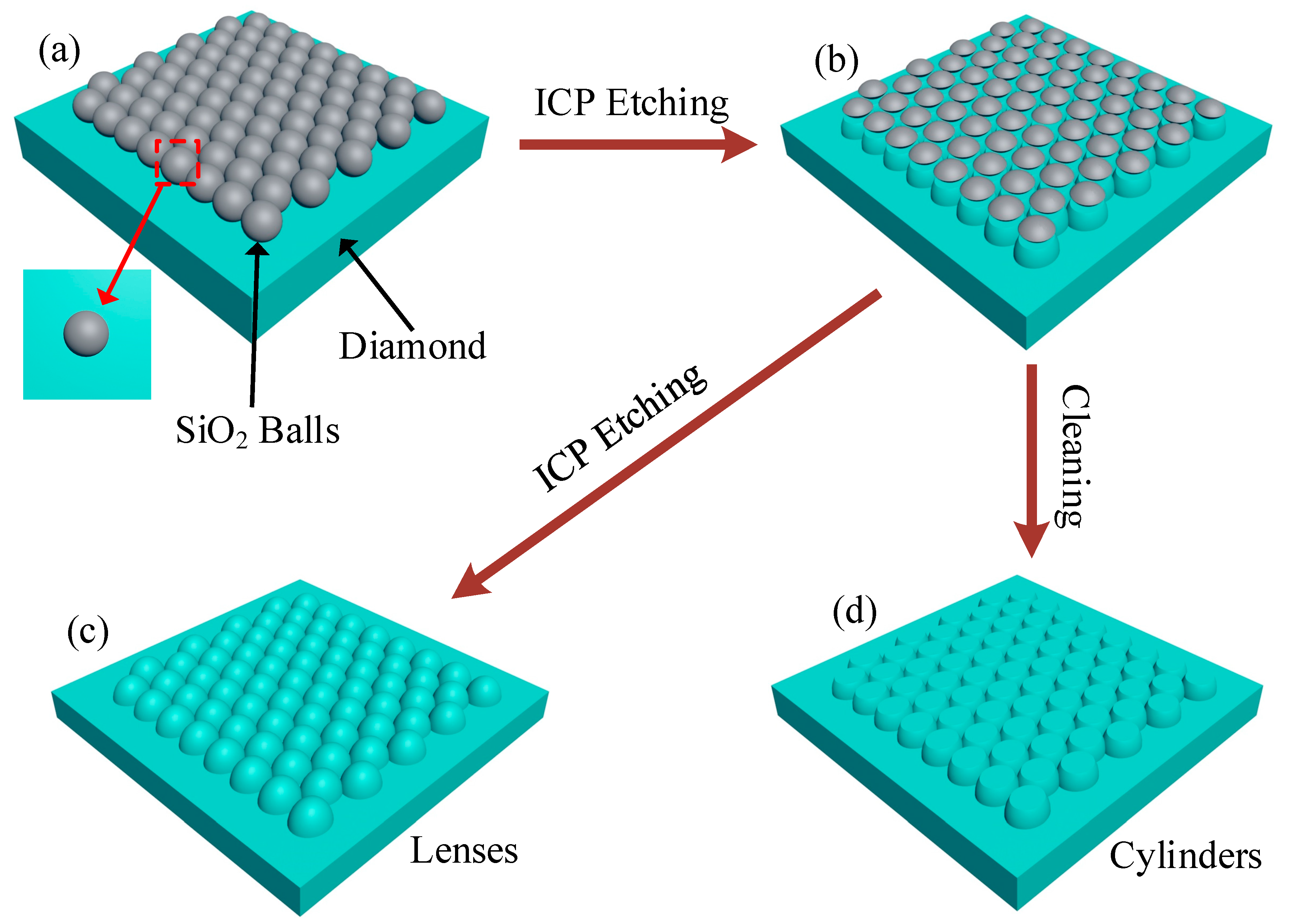
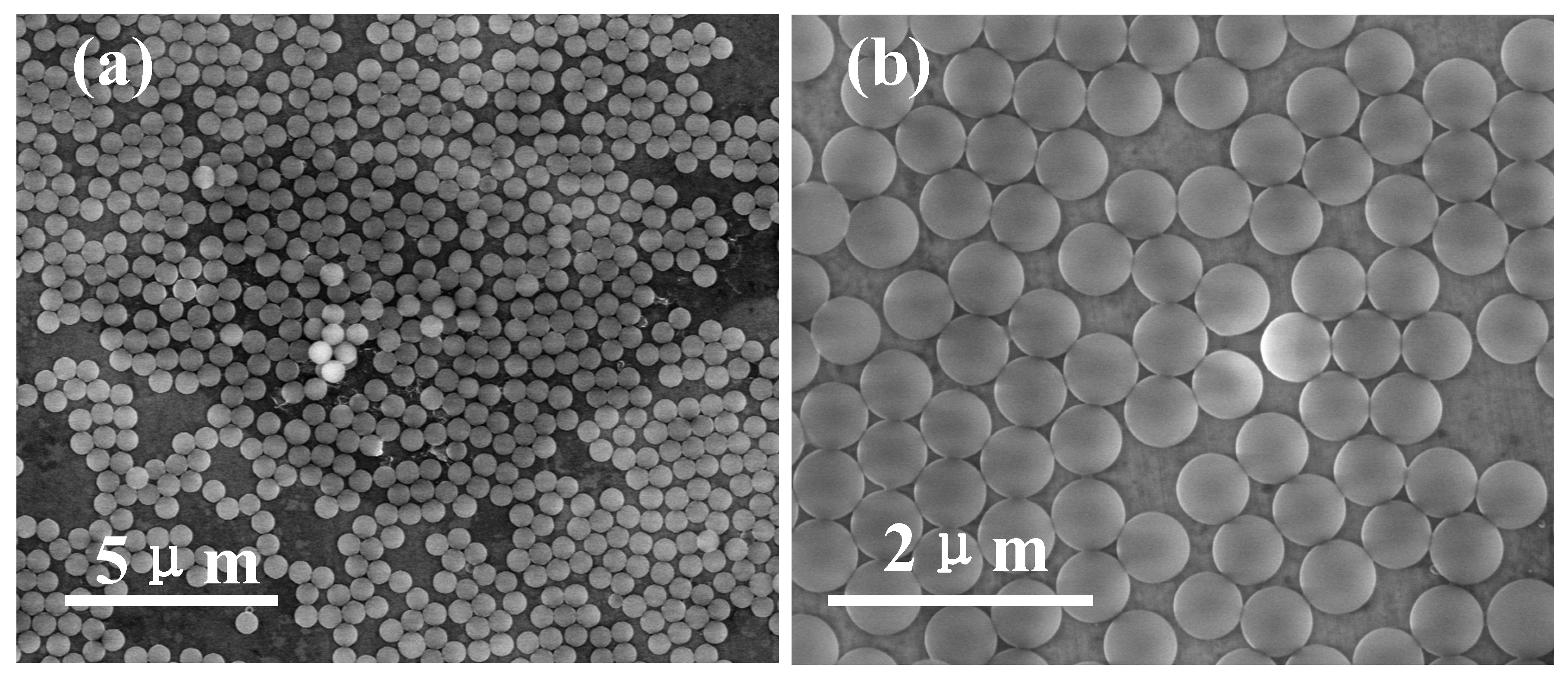


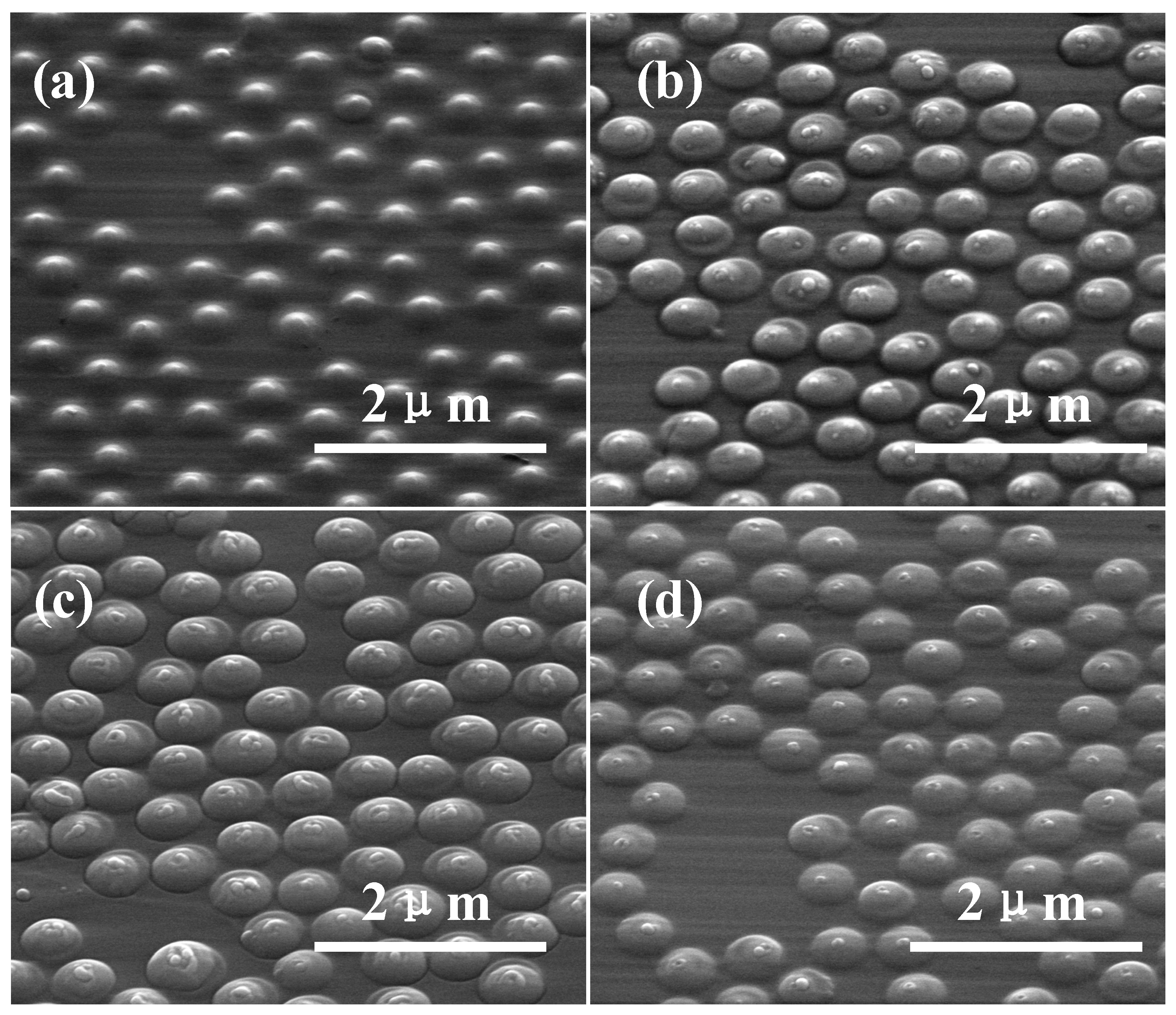
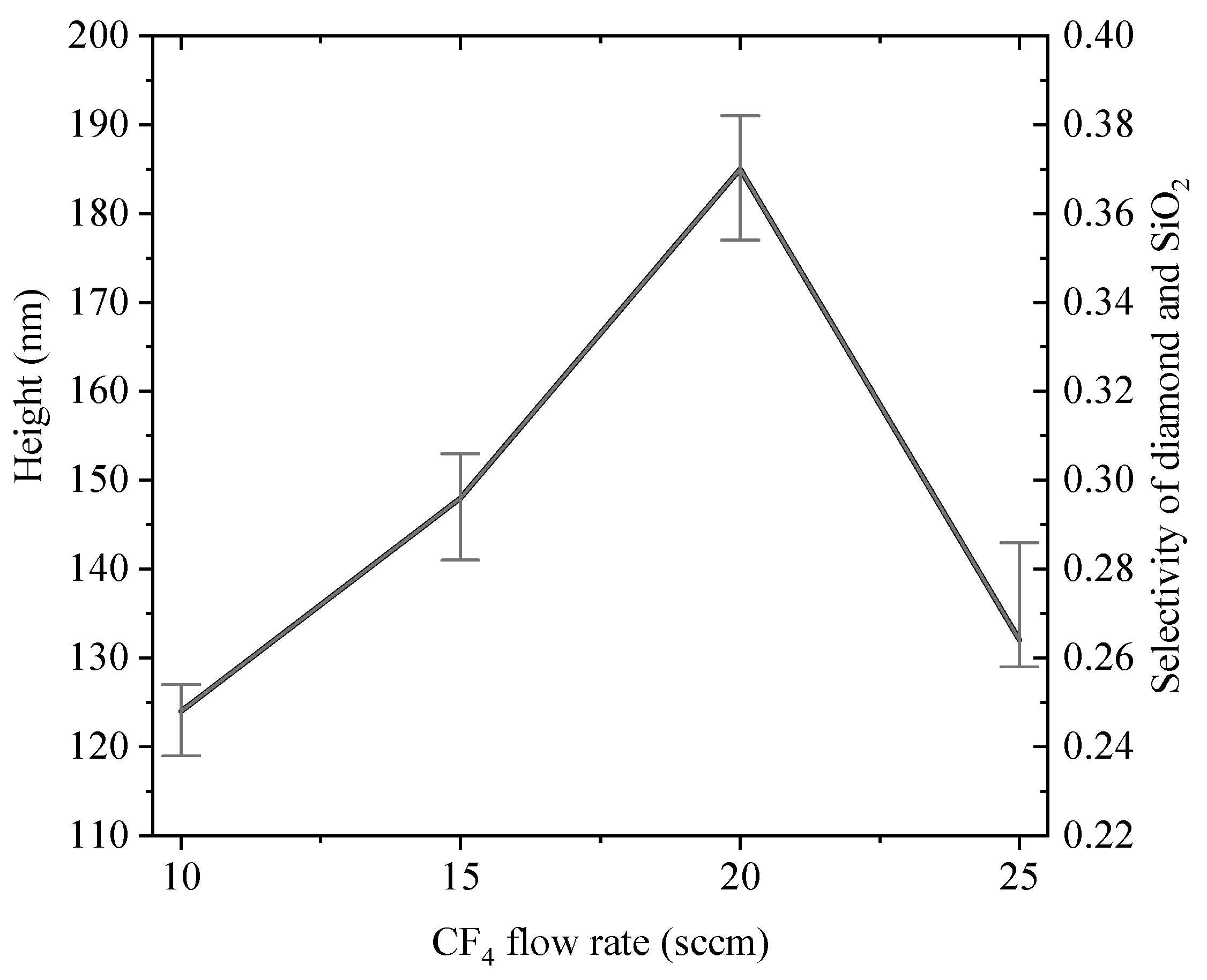
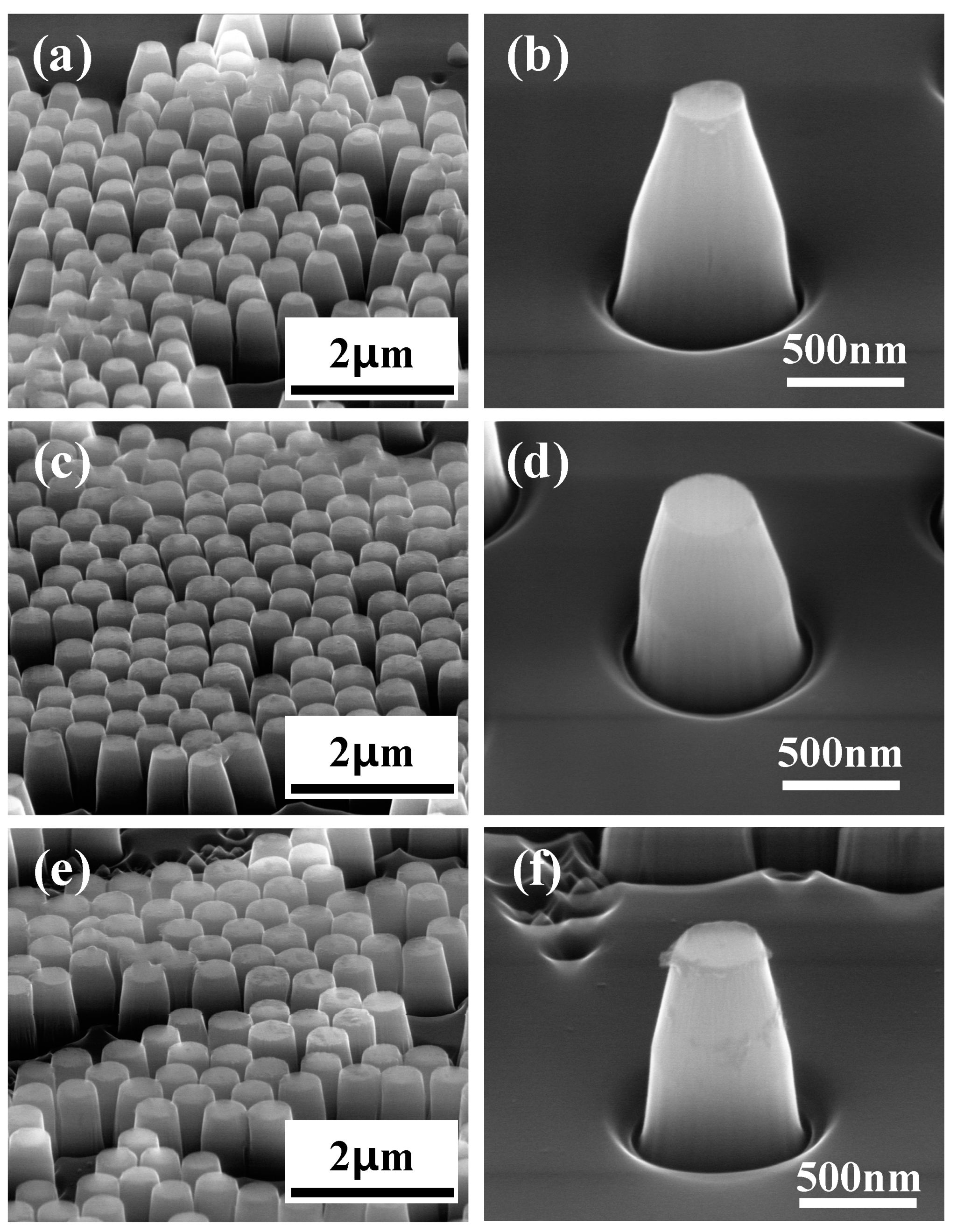

© 2019 by the authors. Licensee MDPI, Basel, Switzerland. This article is an open access article distributed under the terms and conditions of the Creative Commons Attribution (CC BY) license (http://creativecommons.org/licenses/by/4.0/).
Share and Cite
Liu, Z.; Zhu, T.-F.; Wang, Y.-F.; Ahmed, I.; Liu, Z.; Wen, F.; Zhang, X.; Wang, W.; Fan, S.; Wang, K.; et al. Fabrication of Diamond Submicron Lenses and Cylinders by ICP Etching Technique with SiO2 Balls Mask. Materials 2019, 12, 1622. https://doi.org/10.3390/ma12101622
Liu Z, Zhu T-F, Wang Y-F, Ahmed I, Liu Z, Wen F, Zhang X, Wang W, Fan S, Wang K, et al. Fabrication of Diamond Submicron Lenses and Cylinders by ICP Etching Technique with SiO2 Balls Mask. Materials. 2019; 12(10):1622. https://doi.org/10.3390/ma12101622
Chicago/Turabian StyleLiu, Zongchen, Tian-Fei Zhu, Yan-Feng Wang, Irfan Ahmed, Zhangcheng Liu, Feng Wen, Xiaofan Zhang, Wei Wang, Shuwei Fan, Kaiyue Wang, and et al. 2019. "Fabrication of Diamond Submicron Lenses and Cylinders by ICP Etching Technique with SiO2 Balls Mask" Materials 12, no. 10: 1622. https://doi.org/10.3390/ma12101622
APA StyleLiu, Z., Zhu, T.-F., Wang, Y.-F., Ahmed, I., Liu, Z., Wen, F., Zhang, X., Wang, W., Fan, S., Wang, K., & Wang, H.-X. (2019). Fabrication of Diamond Submicron Lenses and Cylinders by ICP Etching Technique with SiO2 Balls Mask. Materials, 12(10), 1622. https://doi.org/10.3390/ma12101622





